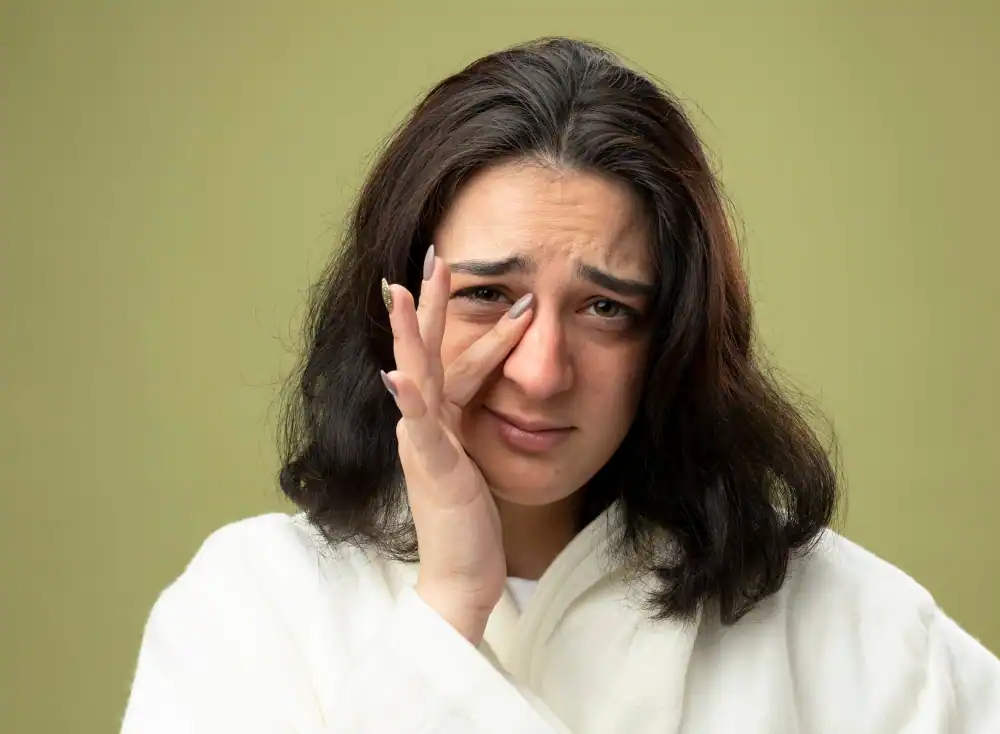A stye, medically referred to as a hordeolum, is a small and painful bump that manifests along the eyelid’s edge, typically in close proximity to the base of the eyelashes.
These nuisances can emerge on either the upper or lower eyelid and might affect one or both eyes simultaneously.
Styes commonly originate from a bacterial infection, predominantly caused by Staphylococcus aureus.
This infection typically takes root within a gland or hair follicle located on the eyelid.

As the infection progresses, it induces inflammation, giving rise to the development of a conspicuous, reddened, and swollen bump.
This bump can sometimes contain pus or other fluids and is often tender or painful when touched.
Types of Styes
There exist two distinct types of styes: the external stye and the internal stye.
An external stye is situated on the outer surface of the eyelid, typically in close proximity to the eyelash line.
In contrast, an internal stye is positioned within the eyelid itself and is generally characterized by heightened pain and discomfort compared to an external stye.
Stye Symptoms
Symptoms of a stye encompass several distinct indicators, which include:
The emergence of a small, crimson bump along the eyelid’s edge, typically in proximity to the eyelash base.
Pain or tenderness in the region affected by the stye.
Noticeable swelling of the eyelid, particularly in the vicinity surrounding the stye.
An itching or burning sensation encircling the eye.
Heightened sensitivity to light.
Discomfort or the sensation of pressure on the affected eye.
Excessive tearing or watery discharge from the eye.
In rare instances, blurred vision may occur as a symptom of a stye.
While styes can be both uncomfortable and aesthetically displeasing, they are generally not considered serious and typically resolve spontaneously within several days to a week.
Nonetheless, if you encounter severe or persistent symptoms or if the stye adversely affects your vision or begins to spread to other parts of the eye, it is imperative to seek medical attention promptly by contacting your healthcare provider.
Treatment of Stye
The management of a stye usually entails the use of home-based remedies and may encompass
Warm compresses: To alleviate pain and diminish swelling, one can effectively apply a clean, warm compress to the affected eye for 10-15 minutes, repeating this process 4-6 times each day.
Eyelid hygiene: Maintaining cleanliness in the affected region and refraining from touching or rubbing the eye are essential practices to prevent additional irritation and potential infection.
Over-the-counter pain medication: Utilizing over-the-counter pain relief medications like ibuprofen or acetaminophen can effectively alleviate pain and discomfort.
Antibiotic ointment or eye drops: If the stye fails to show improvement with home remedies or if it is particularly severe, your healthcare provider may recommend a prescription for antibiotic ointment or eye drops to aid in clearing the infection.
Drainage: In certain instances, the stye may necessitate drainage performed by a qualified healthcare professional to alleviate pain and mitigate the risk of additional complications.
It is crucial to refrain from attempting to squeeze or pop the stye independently, as such actions can potentially exacerbate the infection or contribute to the emergence of a more severe medical condition.
How to Prevent Stye
To prevent styes or reduce the risk of developing a stye, here are some precautions that you can take:
Practice good hygiene: Regularly washing your hands, particularly before handling your eyes, is essential for minimizing the risk of infection.
Avoid sharing personal items: It is crucial to refrain from sharing personal items such as towels, washcloths, or eye makeup that may come into contact with your eyes with others.
This practice serves as a preventive measure to avoid the transmission of infections.
Don’t rub your eyes: Excessive rubbing or touching of your eyes should be avoided, as it can lead to irritation and heighten the likelihood of infection.
Remove eye makeup: Before going to sleep, it is advisable to thoroughly remove eye makeup, including mascara and eyeliner.
This routine prevents the blockage of glands around the eyelid and supports eye health.
Replace contact lenses regularly: If you use contact lenses, it’s essential to adhere to the prescribed replacement timetable and refrain from sleeping while wearing them.
This practice helps minimize the chances of infection and supports eye health.
Treat underlying medical conditions: If you have an underlying medical condition, like blepharitis or rosacea, it is advisable to collaborate with your healthcare provider to effectively manage the condition.
This proactive approach can help mitigate the likelihood of developing a stye.
By implementing these precautionary measures, you can contribute to reducing the risk of stye formation and promote overall eye health.
Is a Stye Contagious
Styes are generally not considered contagious.
They typically result from a bacterial infection within the eyelid’s oil glands, and this infection is typically not transferable from one individual to another.
Nevertheless, it remains crucial to uphold good hygiene practices and abstain from sharing personal items, such as towels or eye makeup, with others.
This precautionary measure helps minimize the potential for infection transmission or irritation.
Furthermore, if you happen to have a stye, it is important to exercise caution by refraining from excessive eye touching or rubbing.
This step is taken to prevent the inadvertent spread of the infection.




